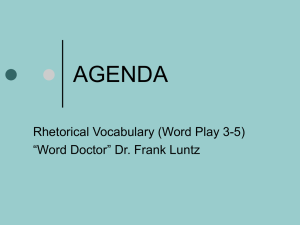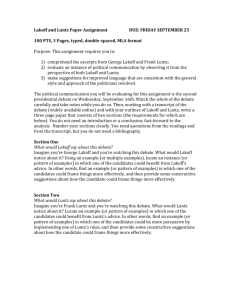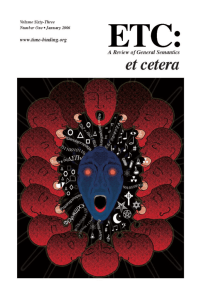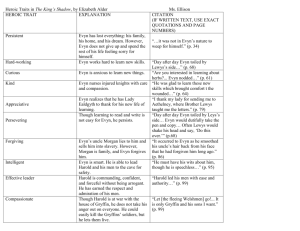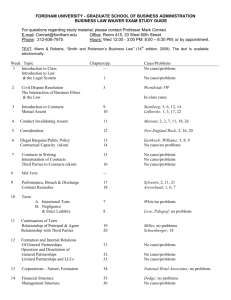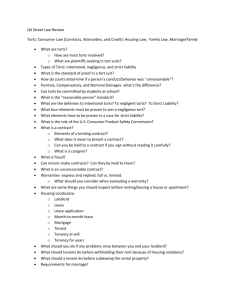harold lunz, november 2002 - The Hon Michael Kirby AC CMG
advertisement
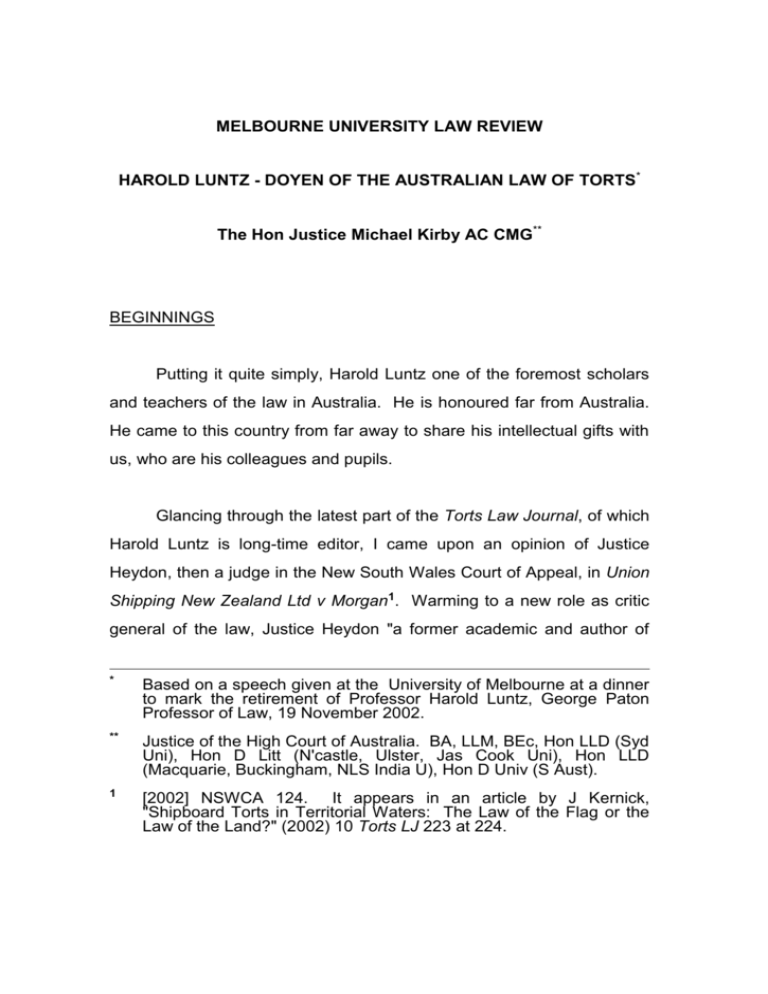
MELBOURNE UNIVERSITY LAW REVIEW HAROLD LUNTZ - DOYEN OF THE AUSTRALIAN LAW OF TORTS* The Hon Justice Michael Kirby AC CMG** BEGINNINGS Putting it quite simply, Harold Luntz one of the foremost scholars and teachers of the law in Australia. He is honoured far from Australia. He came to this country from far away to share his intellectual gifts with us, who are his colleagues and pupils. Glancing through the latest part of the Torts Law Journal, of which Harold Luntz is long-time editor, I came upon an opinion of Justice Heydon, then a judge in the New South Wales Court of Appeal, in Union Shipping New Zealand Ltd v Morgan1. Warming to a new role as critic general of the law, Justice Heydon "a former academic and author of * Based on a speech given at the University of Melbourne at a dinner to mark the retirement of Professor Harold Luntz, George Paton Professor of Law, 19 November 2002. ** Justice of the High Court of Australia. BA, LLM, BEc, Hon LLD (Syd Uni), Hon D Litt (N'castle, Ulster, Jas Cook Uni), Hon LLD (Macquarie, Buckingham, NLS India U), Hon D Univ (S Aust). 1 [2002] NSWCA 124. It appears in an article by J Kernick, "Shipboard Torts in Territorial Waters: The Law of the Flag or the Law of the Land?" (2002) 10 Torts LJ 223 at 224. 2. considerable distinction"2 took aim, this time at his erstwhile academic colleagues. He declared that3: "…Academic legal literature is, like Anglo-Saxon literature, largely a literature of lamentation and complaint. The laments and complaints can be heard even when academic wishes are acceded to". Like much else said of late, such flagellations must be taken with a pinch of salt. Most academic legal literature, like most judicial writing, is penned in a positive spirit. It is designed to help the law in its never ending quest for clear principles, accurate understandings and the advancement of human law and justice4. In my opinion, there is no greater exemplar of these pursuits in academic law in Australia at this time than Harold Luntz. principled. His energy is unbounded. His analysis is His personal attitude is one of politeness mixed with firmness. To this splendid concoction he adds adherence to respect for his fellow human beings and optimism about the future of human society. These are virtues all Australian lawyers can strive to emulate. To find the sources of these qualities, it would be necessary to engage in a biological study of the rare genetic combination that came 2 Kernick, n 1, at 223. 3 Morgan [2002] NSWCA 124 at [98]. 4 M D Kirby, "Welcome to Law Reviews" (2001) 26 MULR 1 at 11. [Add references to Frank Carrigan's article in (2003) 28 MULR and John Gava's riposte]. 3. together in Harold Luntz, born in South Africa in 1937. To do him full justice, I would need to know much more of his ancestors, their struggle and what took them to South Africa rather than, say, Australia or some other part of the world then coloured with so much red. I would need to explore the influence of his teachers at the Athlone Boys' High School in Johannesburg where he was at the time King George VI visited with his family at the dawn of the dark age of apartheid. Those years were ushered in with the election of the National Party government that lasted until Nelson Mandela presided over the birth of the rainbow nation. I would have to explore the influence of his ethnicity and his cultural and religious upbringing to understand fully the response of an outsider to the stern society of laws set in place by the Afrikaner government. I would have to speak to his surviving teachers and fellow pupils in that most distinguished of South African universities, at the Witwatersrand, where he took his primary degrees in arts and law with distinction. I have done none of these things for they would have involved an invasion of the private space of a man always a little reserved who upholds the rights of others because he insists on the same respect for himself. However, I will not leave South Africa, where Harold Luntz received his splendid preparation for a life of legal scholarship, without suggesting that his childhood and youth in that country had a profound effect upon his view of the world and of the law. South Africa was never a lawless State. That, indeed, was the central problem. It embalmed in law rules that anyone with sensitivity (and particularly anyone who was himself or herself from a minority) could see were offensive to human 4. equality, to personal autonomy and to the effective operation of law as an instrument of justice. I venture to suggest that those early years left a mark on Harold Luntz that has stayed with him ever since. They help to explain his sense of urgency, his great energy, his pursuit of justice through law and his search for a better home to give voice to these ideals. It was not unnatural that Harold Luntz should choose Australia. In 1951 the High Court had struck down as unconstitutional, the Communist Party Dissolution Act. It was modelled closely on the Suppression of Terrorism Act of South Africa5. The people of Australia, in their wisdom, had affirmed this decision of the High Court and declined the government's attempt, by referendum, to alter the Constitution. Harold Luntz did not take long to seek out an appointment in Australia. He arrived to the post of Senior Lecturer in Law at the University of Melbourne in August 1965. His departure from his homeland must have seemed a great blow to his University where he had already progressed rapidly to the same rank in the Law Faculty, a development natural enough for the top student in the final year of the law course. He had taken his BCL at Oxford with First Class Honours in 1962. He was ready to conquer new academic worlds. 5 Australian Communist Party v The Commonwealth (1951) 83 CLR 1. 5. It was also natural that he should choose the Law School of the University of Melbourne. Sir Owen Dixon, a great alumnus, in a speech in 1935 commemorating the centenary of the State of Victoria, declared that "virtually from the start, 'the true doctrine [of analytical jurisprudence was] more clearly grasped or better expounded … at the University of Melbourne [than anywhere else]. Dr Hearn came to it", said Sir Owen, "in 1855 as Professor of Modern History and Political Economy, a chair which he relinquished when he became Dean of the Faculty of Law in 1873"6. Thus was established the oldest university law school in Australia. A glance at the postgraduate handbook of the Faculty of Law of the University for 2003 demonstrates beyond question, as Dean Ian Ramsay asserts, that "the Law School combines the traditions of excellence developed over nearly 150 years with innovative approaches to the challenges of legal education and research in the twenty-first century"7. So it was probably inevitable that the gifted young academic from South Africa should choose to come to Melbourne. Fortunate was the University of Melbourne and Australia that he did so. 6 O Dixon, "The Law and the Constitution", in Jesting Pilate (2nd ed, 1997) 38 at 41. 7 I Ramsay, "The Melbourne Law School" in Postgraduate Handbook - Faculty of Law, 3. 6. Recently, at a faculty meeting at which his retirement was marked, Harold Luntz reminded those present of how he was a living link with the traditions and talents of the faculty he found on his arrival. Just to look at the contributors to the Melbourne University Law Review in 19658 confirms what he says. Zelman Cowen (not yet knighted) Sir John Barry (almost appointed to the High Court), Professor Samuel Stoljar, Frank Maher and other authors demonstrated why the University of Melbourne Law School was such a dazzling place. The book review editor of that year was one K M Hayne. reviewers. He chose prudently in books and the Top of the list was Professor Paton's textbook of jurisprudence, edited by David Derham9. This, with a great book by Julius Stone10, was my text on jurisprudence at the Sydney Law School in the early 1960s. Harold Luntz was in due course of time to become the George Paton Professor of Law. Professor Luntz took time off in 1970 to pursue his interests in comparative law as Visiting Associate Professor at Queen's University in Ontario, Canada. In 1971 he was Visiting Professor at the University of California, Berkeley. But his commitment was to Melbourne and Australia. He returned as Reader in Law in July 1971. His professorial chair came in July 1976. He served as Dean over nearly four years from 8 Vol 5 (1965). 9 Reviewed by E K Braybrooke (1965) 5 MULR 103. 10 The Province and Function of Law, Maitland (1946). 7. 1986 to 1988. So committed was he to the duties of teaching and writing at the Melbourne Law School that only once, between 1984 and 1985, did he take an extended period of travel overseas. In that time he was Visiting Fellow at Wolfson College, Oxford. These are the bare bones of a distinguished academic career that is by no means over. The same catalogue of postgraduate courses offered by the Melbourne Law School next year indicates one which I should perhaps myself attend on "current developments in negligence law". The objectives of this course promise to explore the principles of negligence law and the provision of instruction on "developments in relation to those principles in the High Court of Australia and in the highest courts of comparable common law countries"11. As one who has endeavoured to shape negligence law in accordance with a clear principle, or at least a methodology that could command universal assent12, I have now confessed defeat in my attempt13. The three stage test that I favoured, adapted from the House of Lords in Caparo14, has 11 Postgraduate Handbook, above n 7, 70. 12 eg Pyrenees Shire Council v Day (1998) 192 CLR 330 at 419-420; Romeo v Conservation Commission (1998) 198 CLR 431 at 476; Perre v Apand Pty Ltd (1999) 198 CLR 180 at 275 [259]; Crimmins v Stevedoring Committee (1999) 200 CLR 1 at 80-86 [223]-[235]; Brodie v Singleton Shire Council (2001) 75 ALJR 992 at 1039-1040 [241]. 13 Graham Barclays Oysters Pty Ltd v Ryan (2002) 77 ALJR 183 at 229 [238]. 14 Caparo Industries Plc v Dickman [1990] 2 AC 605 at 617-618. See also X (Minors) v Bedfordshire County Council [1995] 2 AC 633 at 728 ff. 8. clearly been rejected by the High Court of Australia15. Unless reform and principle are introduced by legislation (a prospect that seems dubious, to say the least, contemporary legislative motivations being quite different) we are now committed to a search for "salient factual features" or to a return to the womb of Donoghue v Stevenson16. Academic scholars (not, I should say Professor Luntz) rallied to my cause17. But not a single judicial colleague was persuaded and that was where support most mattered. So I say to Professor Luntz that when he gives his postgraduate instruction on developments in what he is pleased to call the "principles" of negligence law, he should keep an eye out for an inconspicuous ageing gentleman sitting in the back row of his class, listening attentively and taking many notes. Indeed, there could be worse developments than to have seven ageing gentlemen (alas no lady) sitting in that back 15 Sullivan v Moody (2001) 75 ALJR 1570; 183 ALR 404; cf Perre v Apand Pty Ltd (1999) 198 CLR 180 at 253 [198]. The "salient factors" referred to by the Court include "vulnerability, power, control, generality or particularity of the class, the resources of, and demands of, the authority", the "core or … non-core" functions or relation to "a matter of policy of executive action" and so on. 16 [1932] AC 562 at 580. Such a move has been suggested in Avenhouse v Hornsby Shire Council (1998) 41 NSWLR 1 at 8 noted in Perre v Apand Pty Ltd (1999) 198 CLR 180 at 253 [198] per Gummow J. 17 N Katter, Duty of Care in Australia (1999) at 173; C Witting, "The Three-Stage Test Abandoned in Australia - Or Not?" (2002) 118 LQR 214. 9. row. If anyone in Australia could throw light on a principled approach to negligence law, it would be Harold Luntz. No one knows more about it. WRITINGS I remember very clearly the first occasion on which I met Harold Luntz. In December 1974 I had been sworn into office as a Deputy President of the Arbitration Commission. After forty days and forty nights, I was appointed to chair the Law Reform Commission, an unexpected development. I there met again Gareth Evans, then a lecturer at the Melbourne Law School. I had known him in the National Union of Australian University Students. He invited me to visit the Law School to discuss the future of the new Commission. The first room that Gareth Evans took me to was that of Harold Luntz. It was upstairs in the old Law School. Before we entered, my host whispered: "This man reads everything". Astonished that there was anyone who could read everything about the law, I was ushered into the presence of a young man then in his mid-thirties. The first thing to catch my attention were his sharp, searching eyes. I thought of those eyes recently when reading a description of Béla Bartók whose eyes were described as "exceptionally shrewd", 10. "whose fire almost burns through his glasses"18. Harold Luntz was also somewhat unusual for a lawyer. He listens before he speaks. Piled on his desk I saw what I assumed was his reading material for that afternoon - several metres of books, law reviews and a thousand loose parts of law reports. Over time I was to discover that Gareth Evans's whispered confidence was correct. This was a scholar with a voracious appetite for information. All was written down in those pre-computer days on cards, searched by a Luntzian technique of using knitting needles that Gareth Evans attempted to copy but abandoned in a fit of uncharacteristic temper and technological incompetence. Everything was fed into Harold Luntz's cards: sorted, analysed, sifted, organised searching all the while with knitting needles for legal principles leading to justice. Anyone who troubles to read of the long course of Harold Luntz's writing (and there must be few authors who have written so much over so long) will readily accept that he is an information processor with few peers. I was told of one celebrated occasion in the Melbourne Law School where a rudimentary system of artificial intelligence was displayed, programmed with case law and other writings on the law of torts. The Law School showed great confidence in Harold Luntz, pitting him against the machine to give an accurate answer on the law of nervous shock. This was before the High Court's decisions in Annets v 18 M Gillies, "Bartók and his Music in the 1990s", in M Gillies The Bartók Companion, Faber, 1993, 1 at 7. 11. New South Wales19 cast, and Gifford v Strang Patrick Stevedoring Pty Ltd20 what I hope, was fresh light on that area of the law (muted though some of the dazzling beams may occasionally seem). Needless to say, Harold Luntz came out on top. He trounced the machine. In much quicker time, and with far greater accuracy, he produced the best analysis of the state of the law. Perhaps we should be grateful that we still live in an age where the human brain, with its rare capacities to conceptualise, select and analyse, can still beat machines. So far no one has been able to programme a machine as good as the brain - and certainly not as good as Harold Luntz's brain. No one has yet attempted to programme a machine with a will to do justice. Harold Luntz's magnum opus was his text on the law of damages21, now into its 4th edition22. It is, putting it plainly, a masterpiece. Fortunately, this was recognised by his own Faculty (often in life, colleagues are reluctant to acknowledge the qualities of one in their midst). In 1983, the University of Melbourne awarded Harold Luntz the degree of Doctor of Laws for the 2nd edition of his text on damages. It is a book that is invariably used and cited, in cases before the High Court dealing with that subject. 19 (2002) 76 ALJR 1348; 191 ALR 449. 20 (2003) 198 ALR 100. 21 Assessment of Damages for Personal Injury and Death (1st ed, 1974); 22 (4th ed, 2002). 12. The High Court's self-denying ordinance that forbids, in most matters, reference to comparable damages verdicts23 (permitting only an occasional exception from this virginal purity24) naturally takes judges who have only occasional opportunities to consider damages questions to the book of the nation's acknowledged expert on the subject 25. Most of the book is concerned with matters of principle. Given the somewhat chaotic way in which the principles of the common law are fashioned in individual cases, decided by judges in every jurisdiction of this and other countries, it is reassuring to see how Professor Luntz can hammer them into a framework of apparently brilliant and seemingly consistent decision-making. I have sometimes suspected that it is his training in the logic of the Roman Dutch law of his original homeland that gave him this conviction that the chaos is actually tamed by logic and seamless order. Certainly, it is his analysis that has helped to reduce disparity and to enhance principle in the law of damages. 23 Planet Fisheries Pty Ltd v La Rosa (1968) 119 CLR 118 at 124; cf Moran v McMahon (1985) 3 NSWLR 700 at 709-711. 24 In Carson v Slee (1993) 178 CLR 44 at 63. The High Court held that a judge presiding in a defamation case could indicate to a jury, for comparative purposes, the ordinary level of the general damages component of personal injury awards and that counsel could make similar references in their addresses; cf M Tilbury and H Luntz, "Punitive Damages in Australian Law" (1995) 17 Loyola of Los Angeles International and Comparative LJ 769 at 7891. 25 See eg Kars v Kars (1996) 187 CLR 354 at 376 where the book and other writings of Professor Luntz are referred to. 13. In addition to this central book, he has written many others worthy of praise. With David Hambly and Robert Hayes he launched in 1980 the first edition of Torts: Cases and Commentary. That work is now in its 5th edition. The publisher's promotion, explaining why another edition was necessary after the 4th in 1995, states that "numerous High Court decisions have impacted on tortious jurisprudence and this edition covers and considers these developments in detail". You will understand that I looked at each chapter to see the treatment by the learned authors of the cases in which I had been involved, many sadly in dissent. I read with much interest on page 14626 the authors' comment about ascertainment of the duty of care in Australian law: "Once Deane J left the High Court in 1995 to become Governor-General, a reaction set in". Considering that it was I who had succeeded Justice Dene to the Court in 1996, for a tantalising moment I wondered whether Harold Luntz might have expressed that idea with greater clarity. Did he mean a "reaction" in the sense of "response"? Or did he mean a backward looking attitude? Or did he mean both? Perhaps, as on so many things, if the different Justices of the High Court were to read the comment (and many more in the book) they would each see a different nuance. I will not even hint as to how I read what was written. I am perfectly happy to 26 H Luntz and D Hambly, Torts - Cases and Commentary (5th ed, 2002). 14. blame Professor Hambly for having authored such mischievous thoughts. In addition to these major texts, and indeed woven through them, have been the writings of Professor Luntz on the subject of Compensation and Rehabilitation27. He had first written a book by that name in 1975. It was in that year (in which I helped inaugurate the Australian Law Reform Commission) that hopes were high that a national compensation scheme would be introduced into Australia, similar to that ushered into life in New Zealand by Sir Own Woodhouse. Harold Luntz has never lost the conviction that this was the way to proceed to a more rational and cost effective system of compensation for personal injuries. As we know, a Bill to establish a national compensation scheme was in the Federal Parliament on 11 November 1975. It fell with the dismissal of the Whitlam Government and the dissolution of the Parliament on that day. It has never been revived. One commentator, writing to me about this address remarked: "In relation to Childe Harold, get hold of the first edition of Luntz, Hambly and Hayes on Torts and see how prescient he was on the forensic lottery, and the costs of not adopting a measured timely federal solution. Of course it was all left too late. Look at the shambles that's unfolding!" 27 AGPS, Canberra (1975). 15. Aside from these major texts, there has been a tremendous flow of timely articles, incisive case notes, engaging book reviews, comments on the direction of the law and other publications. Already in 1963, before he first came to Australia, Harold Luntz was staking his claim as a major scholar in the Annual Survey of South African Law issued by his old Faculty at the University of the Witwatersrand28. Not content with writing the chapter on the law of property (covering no fewer than 35 closely printed pages of great detail), the young academic also wrote the chapter on the law of negotiable instruments (10 pages) and the law of evidence (33 pages). It was a tour de force, in quite diverse areas of the law, showing just how broad were his interests and perceptive his insights. They demonstrate how he could have chosen any area of legal scholarship to make his own. We were fortunate that he sharpened the mind by concentrating, essentially, upon two: torts and damages and negotiable instruments - a special form of property. In 1964, in the South African Law Journal, he was writing on a subject to which he frequently returned, namely the liability in negligence for the person specially susceptible to injury and damage29. The analysis is replete with references to the Institutes and analogies from 28 Juta and Co, 1964. 29 "The man and the thin skull" (1964) 81 South African LJ 18. 16. the times of Justinian considering damage to sick slaves - a question probably not entirely alien to South Africa of those days. Soon after he arrived in Australia, Harold Luntz was writing to the Australian Law Journal on "duties to extraordinary people"30. He also continued to write on the law of cheques, one of his essays on that topic being an early contribution to the Melbourne University Law Review31. Yet for the most part, his core writings have addressed a problem that has gnawed away at his brain over more than thirty years. How to get rationality with fairness in the field of compensation for personal injuries? Even after it seemed clear that the national accident compensation scheme had been abandoned, Harold Luntz concluded a 1980 analysis of liability for injuries during sport with a reminder that this was but a species of a wider genus. He said32: "… The whole field is bedevilled with technicalities and distinctions not related in any way to the needs or deserts of the victims. Many injured persons would have no remedy at all in tort and few would be covered under the alternative compensation systems. In New Zealand, on the other hand, since 1st April 1974, every member of the community, whether injured as a result of a sporting activity or any other type of accident, would be entitled to the benefits payable under the Accident Compensation Act 1972 (NZ). The proposals for a comprehensive national compensation 30 (1968) 42 ALJ 194. 31 H Luntz, "The Banks' Right to Recover on Cheques Paid by Mistake" (1968) 6 MULR 308. 32 H Luntz, "Compensation for Injuries Due to Sport" (1980) 54 ALJ 588 at 601. 17. scheme put forward in 1974 by the National Committee of Inquiry into Compensation and Rehabilitation in Australia (the Woodhouse Committee) have been pigeon-hold too long; it is time they were taken out, dusted off and put into operation in this country". This is a theme that is woven through many later contributions. The capacity of the Trade Practices Act to deliver efficient justice was analysed by him and doubted33. The experiments overseas with particular categories of strict liability were examined and found wanting34. The ventures with such categories in Australia and the suggested organisation of multiple claims in class actions were analysed as temporary remedies on the path to a solution that was universal and more comprehensive35. Harold Luntz continued to hanker for an answer at once larger and bolder, more efficient and just. It is important to make the point that Professor Luntz was never devoted to major tort reform in order to assure lawyers, generations of whom he had taught, an easy living in personal injuries cases. On the contrary, one of his major criticisms of tort law, as practised in Australia, was that it was simply too expensive in the delivery of justice to the individual. It was not cost effective. For example, he pointed to the fact 33 H Luntz, "Section 73 of the Trade Practices Act and the Liability of Financiers for Defects in Goods" (1975) 3 Aust Business L Rev 90. 34 E Brophy and H Luntz, "Statutory Standards as Indicators of the Standard of Care in Negligence: The Nursing Home Context" (1999) 7 Torts LJ 263 at 267. 35 H Luntz, "Heart Valves, Class Actions and Remedies: Lessons for Australia?" in N J Mullany, Torts in the Nineties (1997) 72 at 73. 18. that the successful plaintiff in Rogers v Whittaker36 had to invest, and risk, legal costs of $350,000 to recover damages of $650,000. To Professor Luntz, that highly cost intensive, professional and expensive way of delivering the compensation dollar was simply not rational. So, unlike some others, Harold Luntz's objective has never been simply to shore up the ways of the past because they are the way things have always been. On the contrary, he has been a proponent of truly radical change in the law of torts. Not for him the shreds and patches, the bandaids and the piecemeal reforms. In a sense, he foresaw the inefficiencies and inequalities of the current measures and proposals for reform of the law of torts in Australia. It was his insight that led him to embrace the comprehensive reform adopted in New Zealand. And if some critics of the New Zealand scheme pointed to the fact that the amounts payable under the Accident Compensation Act of that country have fallen away in real terms, at least they appear to have ensured a greater rationality in the treatment of accident compensation than the particular schemes of caps and limitations and multiple changes to legal principles that are now in place or on the table37. It does seem unfortunate that Professor Luntz's call for a return to conceptual thinking about a broader approach to accident compensation 36 (1992) 175 CLR 479 at 488. 37 Review of the Law of Negligence, Final Report (September 2002) (Ipp Report). 19. has not even been considered in the current debates. The perceived urgency has been to respond to the problems of insurance availability and cost. The terms of reference of the Ipp Committee were not interpreted to permit consideration of root and branch reform. The Committee cannot really be blamed for this. The thrust of proposed change was in a different direction. Instead, it seems, we are on the brink of more piecemeal reforms with federal, State and Territory legislation that will almost certainly invite, and not rebuff, litigation and administrative costs simply because of the complexity of the itemised reforms proposed38. In essence, Professor Luntz urged an approach to personal injury compensation was more closely influenced by economic analysis. I do not refer to the economic analysis that will save the viability of a few insurers and make risks more palatable to those who, like the writers of Anglo-Saxon literature, are forever lamenting and complaining. I refer instead to the need to examine foreseeable economic consequences further down the track. For instance, what are the true costs of failing to insist in the conduct of commercial sport that individual defendants are rendered liable for ignoring prevention of injuries with the result that 38 The report makes several recommendations that would reverse or modify decisions of the High Court, eg Rec 3: Rogers v Whitaker (1992) 175 CLR 479; Rec 28: Wyong Shire Council v Shirt (1980) 146 CLR 40; Rec 29: Chappel v Hart (1998) 195 CLR 232; Rec 43: The Commonwealth v Introvigne (1982) 150 CLR 258; Rec 46: Planet Fisheries Pty Ltd v La Rosa (1968) 119 CLR 118; and Rec 51: Griffiths v Kerkemeyer (1977) 139 CLR 161, Kars v Kars (1996) 187 CLR 354. 20. other potential defendants take proper precautions to avoid such injuries? What are the true costs to the community of footballers with broken spines, beyond the individual plaintiffs who sue39? What are the true costs to the community of individual participants in indoor cricket who lose the sight of their eyes because of the peculiar malleability of the indoor cricket ball when it makes contact with the socket of the eye causing such destruction40? What are the true costs of the sports whose codes concentrate on the colour of the players' dress41 rather than on the need for protective gear that is taken for granted in North America and might be introduced here if a few sporting enterprises were rendered liable in damages? In Woods v Multi-Sport Holdings Pty Ltd42 I put it this way43: "The law, and specifically the law of negligence, promotes a greater consideration of the need for safety, accident prevention and the avoidance of needless or excessive injury in sport. In doing so, it promotes the true values of sport rather than the brutal and excessive features that debase sport, leaving victims and their families to pick up the pieces over many years, long after the watching crowd's cheering has subsided". 39 Agar v Hyde (2000) 201 CLR 552; cf H Opie, "The Sport Administrator's Charter: Agar v Hyde" (2001) 9 Torts LJ 131. 40 Woods v Multi-Sport Holdings Pty Ltd (2002) 208 CLR 460. 41 Woods v Multi-Sport Holdings Pty Ltd (2002) 208 CLR 460. 42 Ibid. See K Burns, "Its Just Not Cricket: The High Court, Sport and Legislative Facts" (2002) 10 Torts LJ 234. 43 Woods (2002) 208 CLR 460 at 492 [105]. 21. Economic analysis is needed in tort reform. But it must be long term economics, not short term, complicated and cost-intensive tinkering. As Harold Luntz has often pointed out, the object of all decisions in the law of torts is not only to provide for just loss distribution between the parties. It is also to influence the conduct of others. There can be little doubt that the substitution of the test expressed by the High Court in Rogers v Whittaker44 for the English Bolam test45 made healthcare workers in Australia more forthcoming in explaining risks and options to their patients. Depending upon one's point of view about individual autonomy and human dignity, that outcome is not such a bad thing 46. To reverse or qualify it, as the Ipp Committee has proposed 47, may amount to a return to the philosophy of "nanny knows best" inherited from England. For my own part, I would always be doubtful of any law that committed exclusively to any profession the final judgment on what reasonable care requires. This is just another illustration of the dangers of approaching tort reform in bits and pieces. 44 (1992) 175 CLR 479 at 488; cf Rosenberg v Percival (2000) 205 CLR 434; 178 ALR 577. 45 Bolam v Friern Hospital [1957] 2 All ER 118. 46 E Brophy and H Luntz, above n 34, at 267; H Luntz, "Mrs Whitaker's Gothic Cathedral" (1996) 4 Torts LJ 195 at 197. 47 Ipp Report, above n 37. 22. SCHOLAR AND TEACHER During his life in Australia, Harold Luntz has witnessed enormous changes in the law and its institutions. He has described some of these in reflective essays well worthy of attention48. In one, vividly titled "Throwing Off the Chains"49, he contrasts the attitude to English precedent of Australia at the time he arrived here with the confident, independent approach of today's Australian courts. He cited Deane J's remarks in Hackshaw v Shaw50 explaining why the English categories of liability for particular occupiers of land were bound up with the social structure of England and landholdings that could be traced back to feudal times. Professor Luntz went on51: "Factors such as these make it inevitable that the common law of Australia as developed and adapted by Australian courts, will draw increasingly away from the common law of England in which its roots were located. Statutory amendments of the law will accelerate the trend. At one stage in Australia's history such amendments were frequently based slavishly on English legislation. No longer is this so". 48 H Luntz, "Torts Turnaround Down Under" (2001) 1 Oxford University Commonwealth LJ 95; H Luntz, "Damages" in T Blackshield & Ors (eds), The Oxford Companion to the High Court of Australia (2001) 188 referring to Moran v McMahon (1985) 3 NSWLR 700 at 709. 49 H Luntz, "Throwing Off the Chains - English Precedent and the Law of Torts in Australia" in M P Ellinghaus & Ors (eds), The Emergence of Australian Law (1989). 50 (1984) 155 CLR 614 at 659. 51 H Luntz, "Throwing Off the Chains", above n 48 at 88. 23. In a more recent article, he has commented on the ups and downs of attitudes such as have underpinned the law of torts, observing 52: "Whatever the speculation as to its cause, in 2000 a remarkable turnaround occurred in the outcome of torts appeals in the High Court of Australia. From the date when Sir Anthony Mason took up his appointment as Chief Justice … to the end of 1999 the High Court … delivered some 96 judgments in cases falling under the law of torts … 63 (66%) of those may be seen as pro-plaintiff and 32 (33%) as prodefendant … In 2000 plaintiffs appealed in three cases concerning liability for personal injuries. All of these appeals were dismissed. … Defendants on the other hand were successful in all three of their appeals on issues of liability or damages for personal injury. … Undoubtedly, the judges had what Julius Stone called 'leeways of choice' in all of them. They chose to go in the direction that favoured defendants". Such swings tend to occur in courts over time. Professor Luntz suggests that they may be associated with the cycles of judicial appointments, reflecting, in turn, the cycles of differing governments 53. If that is so, it is simply an incident of our constitutional system of elected government. Academic writing must not complain about it lest it attracts Justice Heydon's castigations. Now locked in mortal combat are a number of great forces that are struggling for the soul of the law of torts. On the one side are those, 52 H Luntz, "Torts Turnaround Down Under", above n 45 at 96-97. 53 Ibid at 106. 24. responding to pressures from particular professional and commercial groups, who seek to cut back what they see as the inefficiencies of the forensic lottery and to do so by a patchwork of legislative caps and special substantive reforms. On the other side, are those who demand that tort law today must be seen in the context of the developing law of human rights54. Unlike the United Kingdom and most other common law countries, Australia has neither a general statute of human rights, nor a constitutional charter of rights, nor access to a regional court of human rights to uphold the principles of liability that conform to general rules protective of human rights55. Undisciplined by such larger principles, we stumble along on an uncertain road to an unclear direction56. Crying in the wilderness, like a prophet of old, is Harold Luntz, appealing for a more fundamental, national, universal and even-handed approach. I asked one member of the Melbourne Law Faculty why Professor Luntz had not served longer as Dean. He was very successful, I was told. He was Dean at the moment when free university education was 54 Discussed J Spigelman, "Access to Justice and Human Rights Treaties" (2000) 22 Sydney L Rev 141. See also book review by I Malkin of Tort Law and Human Rights by J Wright (2001) (2002) 10 Torts LJ 306. 55 cf Osmond v The United Kingdom [1999] 1 FLR 193; Human Rights Act 1998(UK). 56 Australian Broadcasting Corporation v Lenah Game Meats Pty Ltd (2001) 208 CLR 199 at 248-258 [106]-[132]; 277-279 [185]-[191]; 320-329 [313]-[335]; D Lindsay, "Playing possum? Privacy, freedom of speech and the media following ABC v Lenah Game Meats Pty Ltd (2002) 7 Media & Arts Law 161 at 193-194. 25. abandoned and replaced by HECS. He was efficient in difficult times. But this was not what he wanted to do. His life's wish was to be a writer and a teacher. In both of them he excelled. I asked another what was his special genius as a teacher. "Clarity", came back the reply. He did read everything and he knew so much. Yet he had a capacity to cut it back to the very essence and to convey that essence without "over-teaching". He accepted large teaching burdens in "Torts and the Process of Law" in first year. Why did the students like him, I questioned. The answer came back: "Because he is a good storyteller". Torts is about human stories. For Harold Luntz, it is about stories concerning the search for just solutions that solve particular problems but in a context that sets the standards that our community regards as just and reasonable. One could understand that, surveying his life's work in the field of tort law, and looking at the horizon at this moment, he might feel discouraged. Reform he always wanted. But the reforms he can now see being proposed run the risk of compounding the forensic lottery that he has always despised. It risks entrenching its inequalities. So this brings me back to ask what has made Harold Luntz tick. Why this tremendous energy? Why does he read everything? Last year, Harold Luntz took his seat on the Equal Opportunity Committee of the Law School. He is deeply committed to the defence of 26. cultural diversity and to upholding respect for the many different groups that now make up a modern Australian law school. Here, I feel we see his response to the scar of his childhood that led him to leave his homeland of birth and make his life amongst us. Had he stayed in South Africa, he would undoubtedly, like Arthur Chaskalson, Edwin Cameron and other alumni of the Witwatersrand, have become a leader in the struggle for the new South Africa. His motive forces are ultimately a belief that law is an instrument of justice, not just a set of rules. He looks through the words and the formulae to the purpose of it all. He has been an anchor for the intellectual strength and stability not only of the Melbourne Law School but of Australian scholarship in the field of torts. This is no time for him to retire. He must continue to wield his pen, and his words, and his influence - speaking and writing of principle. Looking at us with those sharp, shy, searching eyes57. The need for Harold Luntz in the law of torts in Australia is greater than ever before. So as we celebrate his achievements, we are so bold as to demand more from him. His contribution should not dissipate in a miasma of a celebration. At this watershed in the law of torts in Australia, we need an annual or biennial conference to review where we have come from, where we are and where we are going. Each year it is my privilege to attend, at Yale Law School, a conference on 57 Professor Luntz continues to offer insights into some of the most difficult problems of tort law. See eg "Loss of Chance", Ch 8 in I Freckelton and D Mendelson, Causation in Law and Medicine" (2001) 152. 27. constitutionalism conducted by the Law Faculty and judges from final appellate courts drawn from all parts of the world. It is a great learning experience, and not only for the Faculty. Emboldened by the Melbourne Law Faculty's postgraduate handbook, and by the creative moves that have been taken in recent years by the Melbourne Law School, I have a suggestion to make. There should be a Luntz annual or biennial conference on directions in the law of torts. To it should be invited distinguished judges from overseas and a sprinkling of our own judges. Locked away for a weekend or more with the Law Faculty of the University of Melbourne and with other scholars from here and abroad, such an encounter could inject the best of thinking into the principled application and development of the law of torts. Clearly, Professor Luntz should, of course, be lifetime rapporteur. The papers should be published, some of them in this Review. The visitors should speak to the law students. The dialogue of the judiciary and the academic world should be enhanced and deepened, as it is increasingly the case in Europe and North America. If such symposia happened more often, there might be less need for ad hoc statutes and hasty repairs performed on the run. Perhaps there would also be less need, and less justification, for academic legal literature to offer lamentation and complaint as Justice Heydon said that it does58. Like the Anglo Saxons, after the Conquest, the academics 58 Above n 3. 28. might be ascribed in the citadels of the law they now justly criticise: influencing its values and affecting its directions with their common sense, practical wisdom and plain speaking. Three great strengths of Harold Luntz throughout his long, illustrious career. MELBOURNE UNIVERSITY LAW REVIEW HAROLD LUNTZ - DOYEN OF THE AUSTRALIAN LAW OF TORTS The Hon Justice Michael Kirby AC CMG ABSTRACT Professor Harold Luntz came to the Melbourne Law School from South Africa in 1965. His recent retirement afforded the opportunity to survey the changes that have occurred during his service in the law of torts and in damages for personal injury. The author, by reference to Harold Luntz's writings, reviews the emergence of a distinctive Australian body of law, freed from the controls of English law. The resulting outcome is not always clear. For example, Australia has resisted Professor Luntz's call to embrace the New Zealand accident compensation system as a more just and cost effective way to deliver the compensation dollar. In the context of current national and State moves to introduce special legislation with caps and limitations, the author suggests that a struggle is underway for the future of the law of torts. He proposes an annual or biennial symposium to continue the intellectual work on torts law carried on by Professor Luntz as doyen of Australia's law of torts.

